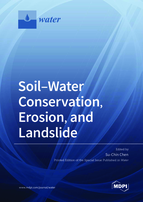Soil–Water Conservation, Erosion, and Landslide
A special issue of Water (ISSN 2073-4441). This special issue belongs to the section "Water Erosion and Sediment Transport".
Deadline for manuscript submissions: closed (30 June 2021) | Viewed by 72513
Special Issue Editor
Interests: sediment transport; soil erosion and scour; dam breach; landslides; vegetation restoration; eco-hydrology; disaster mitigation
Special Issues, Collections and Topics in MDPI journals
Special Issue Information
Dear Colleagues,
The predicted climate change is likely to cause extreme storm events and, subsequently, catastrophic disasters, including soil erosion, debris and landslide formation, loss of life, etc. In the decade from 1976, natural disasters affected less than a billion lives. These numbers have surged in the last decade alone. It is said that natural disasters have affected over 3 billion lives, killed on average 750,000 people, and cost more than US$ 600 billion. Of these numbers, a greater proportion are due to sediment-related disasters, and these numbers are an indication of the amount of work still to be done in the field of soil erosion, conservation, and landslides. Scientists, engineers, and planners are all under immense pressure to develop and improve existing scientific tools to model erosion and landslides and, in the process, better conserve the soil. Therefore, the purpose of this Special Issue is to improve our knowledge on the processes and mechanics of soil erosion and landslides. In turn, these will be crucial in developing the right tools and models for soil and water conservation, disaster mitigation, and early warning systems. Original work submitted on this Special Issue will be given preferential treatment; moreover, papers focusing on the key processes of soil erosion, mechanics of sediment transport, and unconventional tools and methods on these subjects are welcome.
Prof. Su-Chin Chen
Guest Editor
Manuscript Submission Information
Manuscripts should be submitted online at www.mdpi.com by registering and logging in to this website. Once you are registered, click here to go to the submission form. Manuscripts can be submitted until the deadline. All submissions that pass pre-check are peer-reviewed. Accepted papers will be published continuously in the journal (as soon as accepted) and will be listed together on the special issue website. Research articles, review articles as well as short communications are invited. For planned papers, a title and short abstract (about 100 words) can be sent to the Editorial Office for announcement on this website.
Submitted manuscripts should not have been published previously, nor be under consideration for publication elsewhere (except conference proceedings papers). All manuscripts are thoroughly refereed through a single-blind peer-review process. A guide for authors and other relevant information for submission of manuscripts is available on the Instructions for Authors page. Water is an international peer-reviewed open access semimonthly journal published by MDPI.
Please visit the Instructions for Authors page before submitting a manuscript. The Article Processing Charge (APC) for publication in this open access journal is 2600 CHF (Swiss Francs). Submitted papers should be well formatted and use good English. Authors may use MDPI's English editing service prior to publication or during author revisions.
Keywords
- soil and water conservation
- soil erosion
- sediment yield
- sediment budget
- erosion control
- debris flow
- shallow landslide
- deep-seated landslide
- vegetation restoration
- disaster mitigation






